The Role of ICT in Enhancing Learning in Pakistan's Secondary Schools
VerifiedAdded on 2023/02/13
|5
|1619
|204
Report
AI Summary
This report investigates the utilization of Information and Communication Technology (ICT) within secondary schools in Pakistan, addressing key research questions regarding its application and impact on student learning. The study explores the ways in which ICT can enhance student progress and competence. The methodology involves online questionnaires and data analysis using SPSS, including descriptive and inferential statistics. The findings are expected to highlight the current state of ICT integration, the challenges faced, and the potential benefits for students. The conclusion emphasizes the importance of research in low- to moderate-tech settings to inform education policy and showcases diverse digital learning abilities. The report also considers the influence of new technologies such as computers, cellphones, and tablets on students' digital literacy skills, referencing relevant literature and reports such as the UNESCO Global Education Monitoring Report (2016) and OECD reports. The study aims to provide valuable insights for policymakers and educators in Pakistan, contributing to the effective integration of ICT in the educational system.
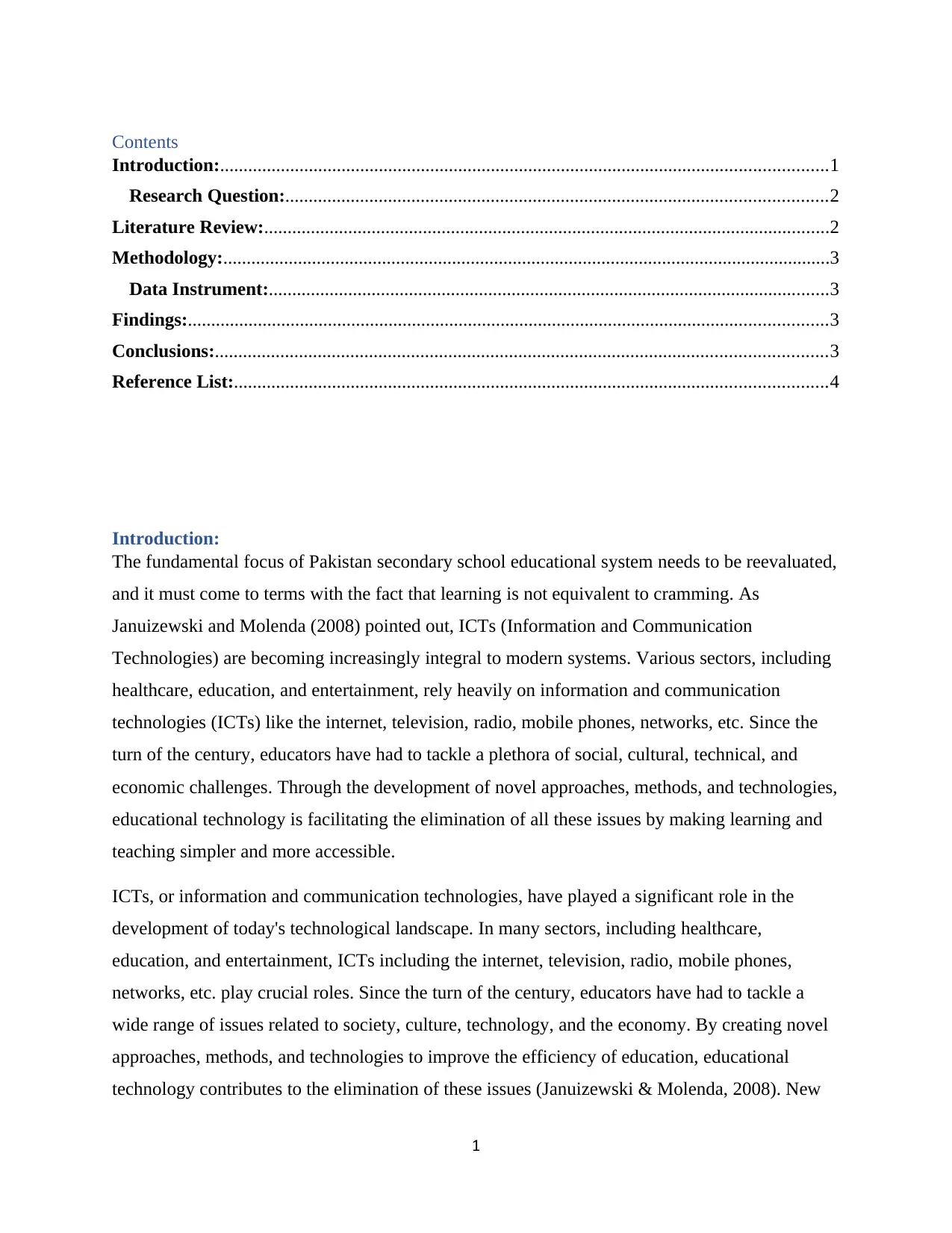
Contents
Introduction:..................................................................................................................................1
Research Question:....................................................................................................................2
Literature Review:.........................................................................................................................2
Methodology:..................................................................................................................................3
Data Instrument:........................................................................................................................3
Findings:.........................................................................................................................................3
Conclusions:...................................................................................................................................3
Reference List:...............................................................................................................................4
Introduction:
The fundamental focus of Pakistan secondary school educational system needs to be reevaluated,
and it must come to terms with the fact that learning is not equivalent to cramming. As
Januizewski and Molenda (2008) pointed out, ICTs (Information and Communication
Technologies) are becoming increasingly integral to modern systems. Various sectors, including
healthcare, education, and entertainment, rely heavily on information and communication
technologies (ICTs) like the internet, television, radio, mobile phones, networks, etc. Since the
turn of the century, educators have had to tackle a plethora of social, cultural, technical, and
economic challenges. Through the development of novel approaches, methods, and technologies,
educational technology is facilitating the elimination of all these issues by making learning and
teaching simpler and more accessible.
ICTs, or information and communication technologies, have played a significant role in the
development of today's technological landscape. In many sectors, including healthcare,
education, and entertainment, ICTs including the internet, television, radio, mobile phones,
networks, etc. play crucial roles. Since the turn of the century, educators have had to tackle a
wide range of issues related to society, culture, technology, and the economy. By creating novel
approaches, methods, and technologies to improve the efficiency of education, educational
technology contributes to the elimination of these issues (Januizewski & Molenda, 2008). New
1
Introduction:..................................................................................................................................1
Research Question:....................................................................................................................2
Literature Review:.........................................................................................................................2
Methodology:..................................................................................................................................3
Data Instrument:........................................................................................................................3
Findings:.........................................................................................................................................3
Conclusions:...................................................................................................................................3
Reference List:...............................................................................................................................4
Introduction:
The fundamental focus of Pakistan secondary school educational system needs to be reevaluated,
and it must come to terms with the fact that learning is not equivalent to cramming. As
Januizewski and Molenda (2008) pointed out, ICTs (Information and Communication
Technologies) are becoming increasingly integral to modern systems. Various sectors, including
healthcare, education, and entertainment, rely heavily on information and communication
technologies (ICTs) like the internet, television, radio, mobile phones, networks, etc. Since the
turn of the century, educators have had to tackle a plethora of social, cultural, technical, and
economic challenges. Through the development of novel approaches, methods, and technologies,
educational technology is facilitating the elimination of all these issues by making learning and
teaching simpler and more accessible.
ICTs, or information and communication technologies, have played a significant role in the
development of today's technological landscape. In many sectors, including healthcare,
education, and entertainment, ICTs including the internet, television, radio, mobile phones,
networks, etc. play crucial roles. Since the turn of the century, educators have had to tackle a
wide range of issues related to society, culture, technology, and the economy. By creating novel
approaches, methods, and technologies to improve the efficiency of education, educational
technology contributes to the elimination of these issues (Januizewski & Molenda, 2008). New
1
Paraphrase This Document
Need a fresh take? Get an instant paraphrase of this document with our AI Paraphraser
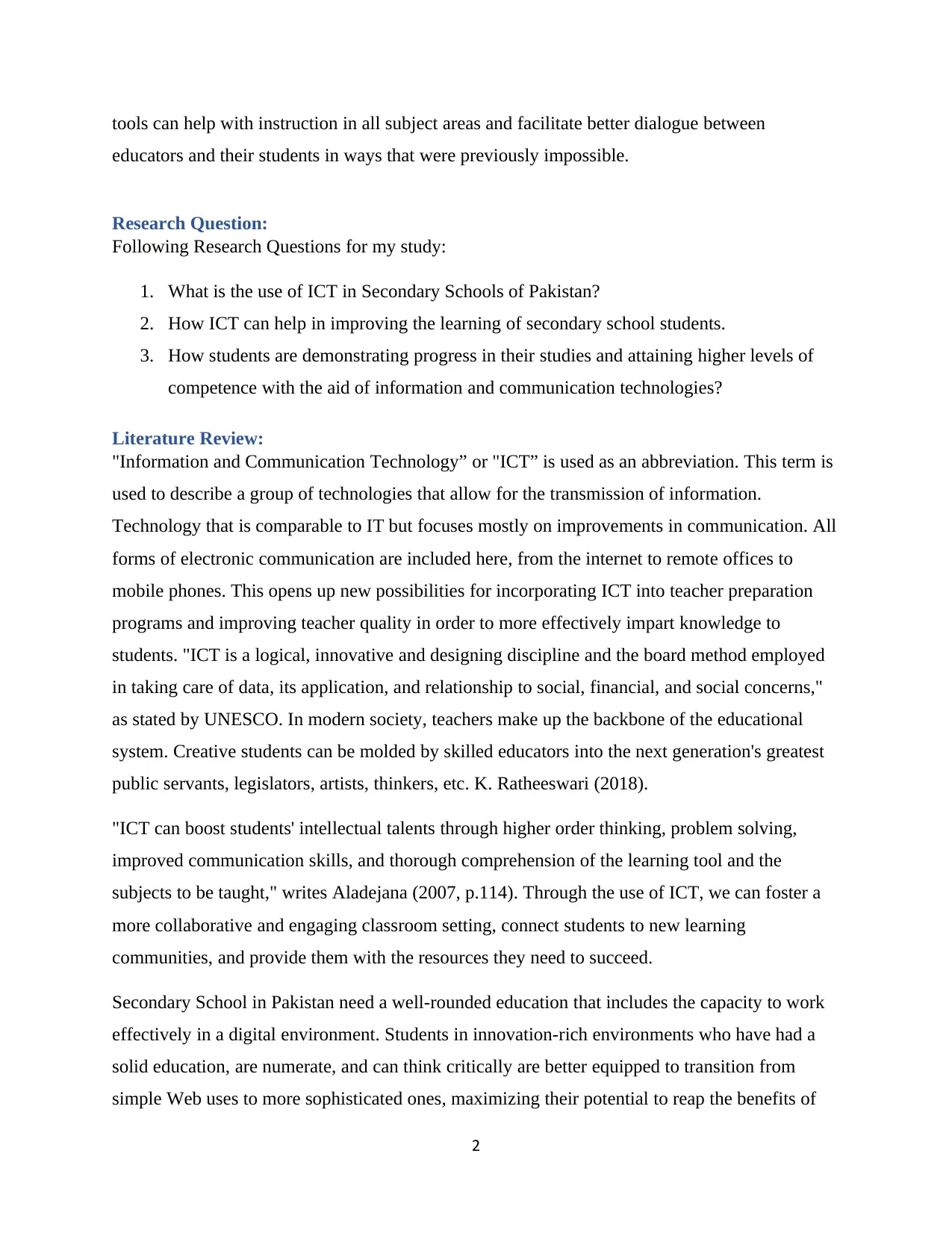
tools can help with instruction in all subject areas and facilitate better dialogue between
educators and their students in ways that were previously impossible.
Research Question:
Following Research Questions for my study:
1. What is the use of ICT in Secondary Schools of Pakistan?
2. How ICT can help in improving the learning of secondary school students.
3. How students are demonstrating progress in their studies and attaining higher levels of
competence with the aid of information and communication technologies?
Literature Review:
"Information and Communication Technology” or "ICT” is used as an abbreviation. This term is
used to describe a group of technologies that allow for the transmission of information.
Technology that is comparable to IT but focuses mostly on improvements in communication. All
forms of electronic communication are included here, from the internet to remote offices to
mobile phones. This opens up new possibilities for incorporating ICT into teacher preparation
programs and improving teacher quality in order to more effectively impart knowledge to
students. "ICT is a logical, innovative and designing discipline and the board method employed
in taking care of data, its application, and relationship to social, financial, and social concerns,"
as stated by UNESCO. In modern society, teachers make up the backbone of the educational
system. Creative students can be molded by skilled educators into the next generation's greatest
public servants, legislators, artists, thinkers, etc. K. Ratheeswari (2018).
"ICT can boost students' intellectual talents through higher order thinking, problem solving,
improved communication skills, and thorough comprehension of the learning tool and the
subjects to be taught," writes Aladejana (2007, p.114). Through the use of ICT, we can foster a
more collaborative and engaging classroom setting, connect students to new learning
communities, and provide them with the resources they need to succeed.
Secondary School in Pakistan need a well-rounded education that includes the capacity to work
effectively in a digital environment. Students in innovation-rich environments who have had a
solid education, are numerate, and can think critically are better equipped to transition from
simple Web uses to more sophisticated ones, maximizing their potential to reap the benefits of
2
educators and their students in ways that were previously impossible.
Research Question:
Following Research Questions for my study:
1. What is the use of ICT in Secondary Schools of Pakistan?
2. How ICT can help in improving the learning of secondary school students.
3. How students are demonstrating progress in their studies and attaining higher levels of
competence with the aid of information and communication technologies?
Literature Review:
"Information and Communication Technology” or "ICT” is used as an abbreviation. This term is
used to describe a group of technologies that allow for the transmission of information.
Technology that is comparable to IT but focuses mostly on improvements in communication. All
forms of electronic communication are included here, from the internet to remote offices to
mobile phones. This opens up new possibilities for incorporating ICT into teacher preparation
programs and improving teacher quality in order to more effectively impart knowledge to
students. "ICT is a logical, innovative and designing discipline and the board method employed
in taking care of data, its application, and relationship to social, financial, and social concerns,"
as stated by UNESCO. In modern society, teachers make up the backbone of the educational
system. Creative students can be molded by skilled educators into the next generation's greatest
public servants, legislators, artists, thinkers, etc. K. Ratheeswari (2018).
"ICT can boost students' intellectual talents through higher order thinking, problem solving,
improved communication skills, and thorough comprehension of the learning tool and the
subjects to be taught," writes Aladejana (2007, p.114). Through the use of ICT, we can foster a
more collaborative and engaging classroom setting, connect students to new learning
communities, and provide them with the resources they need to succeed.
Secondary School in Pakistan need a well-rounded education that includes the capacity to work
effectively in a digital environment. Students in innovation-rich environments who have had a
solid education, are numerate, and can think critically are better equipped to transition from
simple Web uses to more sophisticated ones, maximizing their potential to reap the benefits of
2
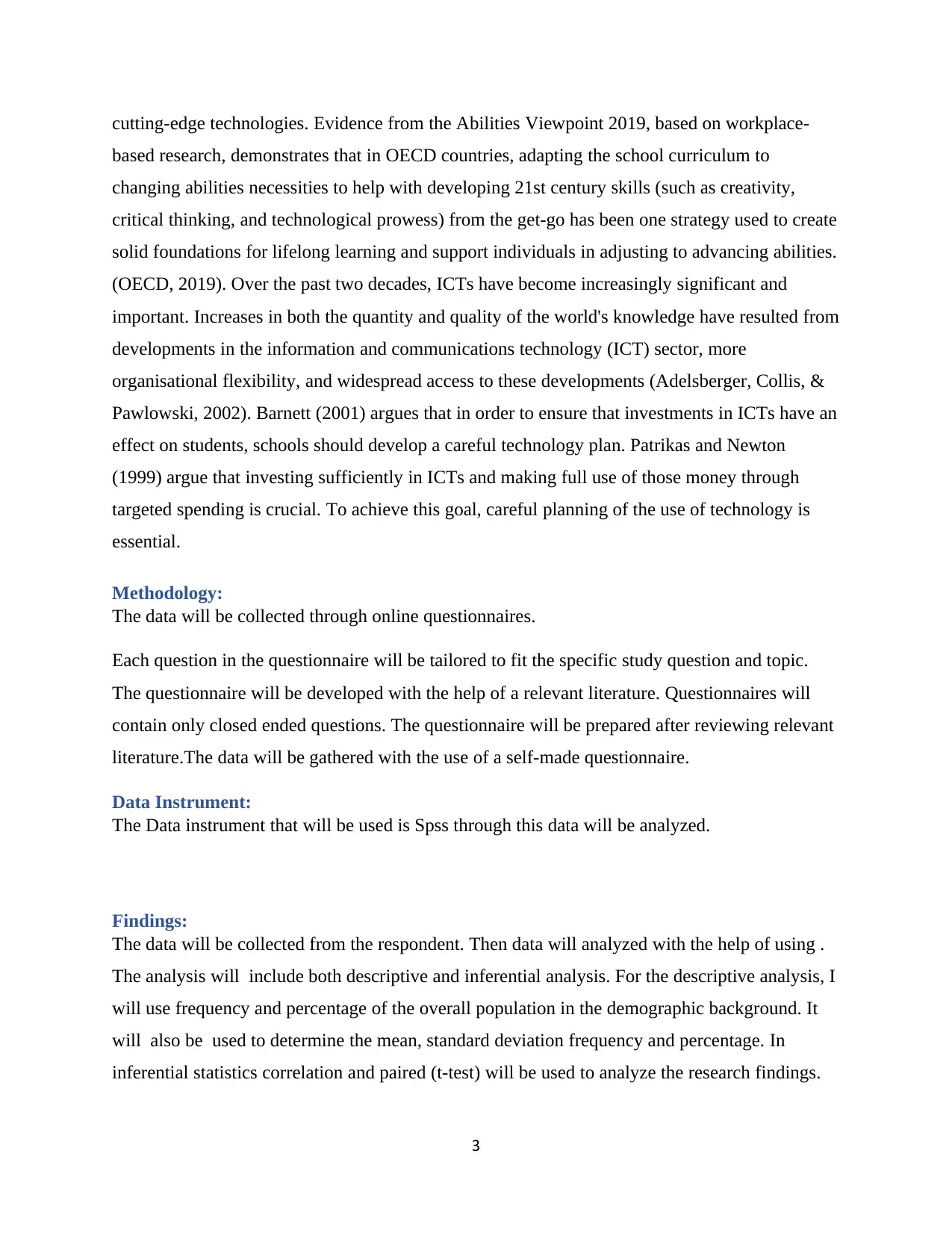
cutting-edge technologies. Evidence from the Abilities Viewpoint 2019, based on workplace-
based research, demonstrates that in OECD countries, adapting the school curriculum to
changing abilities necessities to help with developing 21st century skills (such as creativity,
critical thinking, and technological prowess) from the get-go has been one strategy used to create
solid foundations for lifelong learning and support individuals in adjusting to advancing abilities.
(OECD, 2019). Over the past two decades, ICTs have become increasingly significant and
important. Increases in both the quantity and quality of the world's knowledge have resulted from
developments in the information and communications technology (ICT) sector, more
organisational flexibility, and widespread access to these developments (Adelsberger, Collis, &
Pawlowski, 2002). Barnett (2001) argues that in order to ensure that investments in ICTs have an
effect on students, schools should develop a careful technology plan. Patrikas and Newton
(1999) argue that investing sufficiently in ICTs and making full use of those money through
targeted spending is crucial. To achieve this goal, careful planning of the use of technology is
essential.
Methodology:
The data will be collected through online questionnaires.
Each question in the questionnaire will be tailored to fit the specific study question and topic.
The questionnaire will be developed with the help of a relevant literature. Questionnaires will
contain only closed ended questions. The questionnaire will be prepared after reviewing relevant
literature.The data will be gathered with the use of a self-made questionnaire.
Data Instrument:
The Data instrument that will be used is Spss through this data will be analyzed.
Findings:
The data will be collected from the respondent. Then data will analyzed with the help of using .
The analysis will include both descriptive and inferential analysis. For the descriptive analysis, I
will use frequency and percentage of the overall population in the demographic background. It
will also be used to determine the mean, standard deviation frequency and percentage. In
inferential statistics correlation and paired (t-test) will be used to analyze the research findings.
3
based research, demonstrates that in OECD countries, adapting the school curriculum to
changing abilities necessities to help with developing 21st century skills (such as creativity,
critical thinking, and technological prowess) from the get-go has been one strategy used to create
solid foundations for lifelong learning and support individuals in adjusting to advancing abilities.
(OECD, 2019). Over the past two decades, ICTs have become increasingly significant and
important. Increases in both the quantity and quality of the world's knowledge have resulted from
developments in the information and communications technology (ICT) sector, more
organisational flexibility, and widespread access to these developments (Adelsberger, Collis, &
Pawlowski, 2002). Barnett (2001) argues that in order to ensure that investments in ICTs have an
effect on students, schools should develop a careful technology plan. Patrikas and Newton
(1999) argue that investing sufficiently in ICTs and making full use of those money through
targeted spending is crucial. To achieve this goal, careful planning of the use of technology is
essential.
Methodology:
The data will be collected through online questionnaires.
Each question in the questionnaire will be tailored to fit the specific study question and topic.
The questionnaire will be developed with the help of a relevant literature. Questionnaires will
contain only closed ended questions. The questionnaire will be prepared after reviewing relevant
literature.The data will be gathered with the use of a self-made questionnaire.
Data Instrument:
The Data instrument that will be used is Spss through this data will be analyzed.
Findings:
The data will be collected from the respondent. Then data will analyzed with the help of using .
The analysis will include both descriptive and inferential analysis. For the descriptive analysis, I
will use frequency and percentage of the overall population in the demographic background. It
will also be used to determine the mean, standard deviation frequency and percentage. In
inferential statistics correlation and paired (t-test) will be used to analyze the research findings.
3
⊘ This is a preview!⊘
Do you want full access?
Subscribe today to unlock all pages.

Trusted by 1+ million students worldwide
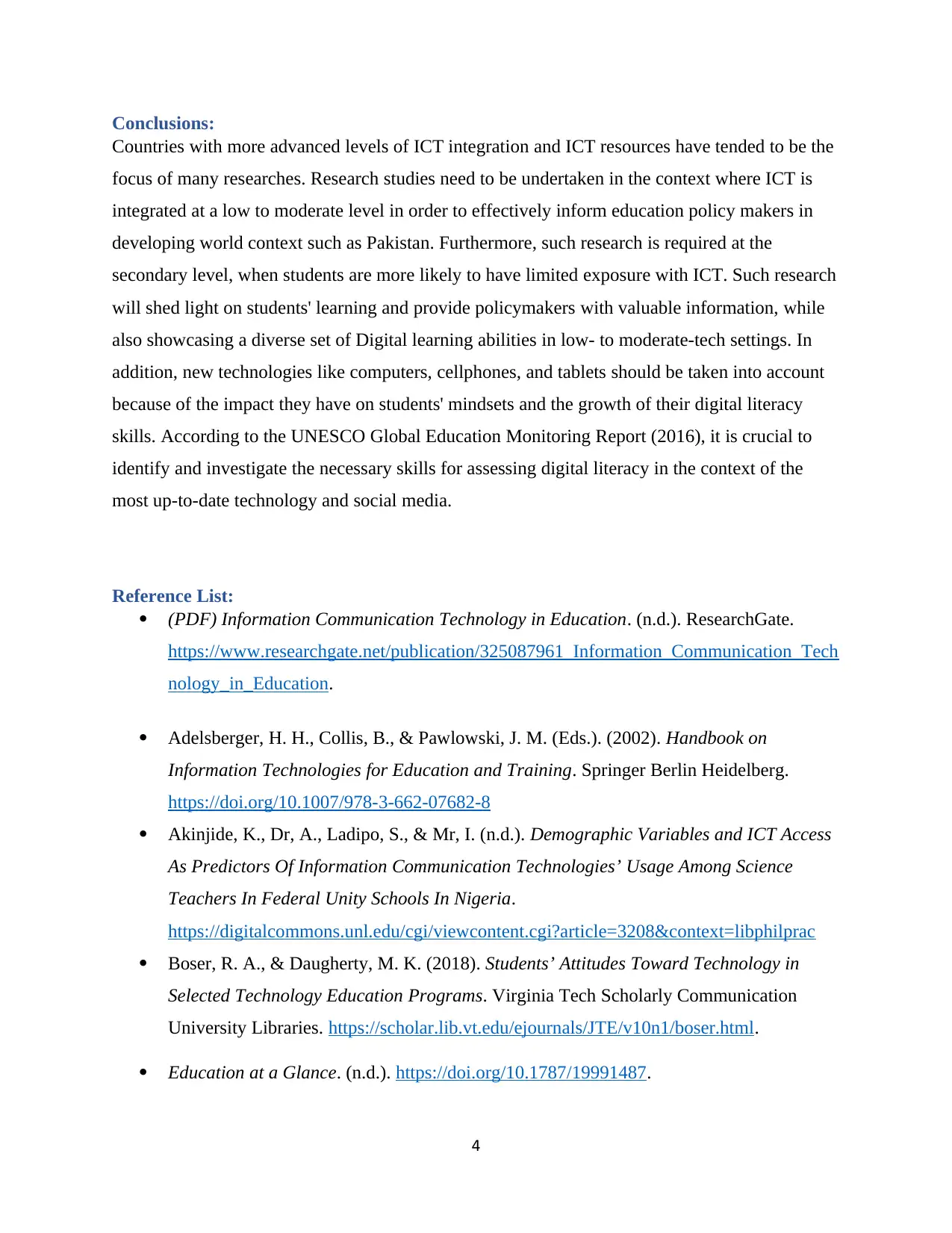
Conclusions:
Countries with more advanced levels of ICT integration and ICT resources have tended to be the
focus of many researches. Research studies need to be undertaken in the context where ICT is
integrated at a low to moderate level in order to effectively inform education policy makers in
developing world context such as Pakistan. Furthermore, such research is required at the
secondary level, when students are more likely to have limited exposure with ICT. Such research
will shed light on students' learning and provide policymakers with valuable information, while
also showcasing a diverse set of Digital learning abilities in low- to moderate-tech settings. In
addition, new technologies like computers, cellphones, and tablets should be taken into account
because of the impact they have on students' mindsets and the growth of their digital literacy
skills. According to the UNESCO Global Education Monitoring Report (2016), it is crucial to
identify and investigate the necessary skills for assessing digital literacy in the context of the
most up-to-date technology and social media.
Reference List:
(PDF) Information Communication Technology in Education. (n.d.). ResearchGate.
https://www.researchgate.net/publication/325087961_Information_Communication_Tech
nology_in_Education.
Adelsberger, H. H., Collis, B., & Pawlowski, J. M. (Eds.). (2002). Handbook on
Information Technologies for Education and Training. Springer Berlin Heidelberg.
https://doi.org/10.1007/978-3-662-07682-8
Akinjide, K., Dr, A., Ladipo, S., & Mr, I. (n.d.). Demographic Variables and ICT Access
As Predictors Of Information Communication Technologies’ Usage Among Science
Teachers In Federal Unity Schools In Nigeria.
https://digitalcommons.unl.edu/cgi/viewcontent.cgi?article=3208&context=libphilprac
Boser, R. A., & Daugherty, M. K. (2018). Students’ Attitudes Toward Technology in
Selected Technology Education Programs. Virginia Tech Scholarly Communication
University Libraries. https://scholar.lib.vt.edu/ejournals/JTE/v10n1/boser.html.
Education at a Glance. (n.d.). https://doi.org/10.1787/19991487.
4
Countries with more advanced levels of ICT integration and ICT resources have tended to be the
focus of many researches. Research studies need to be undertaken in the context where ICT is
integrated at a low to moderate level in order to effectively inform education policy makers in
developing world context such as Pakistan. Furthermore, such research is required at the
secondary level, when students are more likely to have limited exposure with ICT. Such research
will shed light on students' learning and provide policymakers with valuable information, while
also showcasing a diverse set of Digital learning abilities in low- to moderate-tech settings. In
addition, new technologies like computers, cellphones, and tablets should be taken into account
because of the impact they have on students' mindsets and the growth of their digital literacy
skills. According to the UNESCO Global Education Monitoring Report (2016), it is crucial to
identify and investigate the necessary skills for assessing digital literacy in the context of the
most up-to-date technology and social media.
Reference List:
(PDF) Information Communication Technology in Education. (n.d.). ResearchGate.
https://www.researchgate.net/publication/325087961_Information_Communication_Tech
nology_in_Education.
Adelsberger, H. H., Collis, B., & Pawlowski, J. M. (Eds.). (2002). Handbook on
Information Technologies for Education and Training. Springer Berlin Heidelberg.
https://doi.org/10.1007/978-3-662-07682-8
Akinjide, K., Dr, A., Ladipo, S., & Mr, I. (n.d.). Demographic Variables and ICT Access
As Predictors Of Information Communication Technologies’ Usage Among Science
Teachers In Federal Unity Schools In Nigeria.
https://digitalcommons.unl.edu/cgi/viewcontent.cgi?article=3208&context=libphilprac
Boser, R. A., & Daugherty, M. K. (2018). Students’ Attitudes Toward Technology in
Selected Technology Education Programs. Virginia Tech Scholarly Communication
University Libraries. https://scholar.lib.vt.edu/ejournals/JTE/v10n1/boser.html.
Education at a Glance. (n.d.). https://doi.org/10.1787/19991487.
4
Paraphrase This Document
Need a fresh take? Get an instant paraphrase of this document with our AI Paraphraser
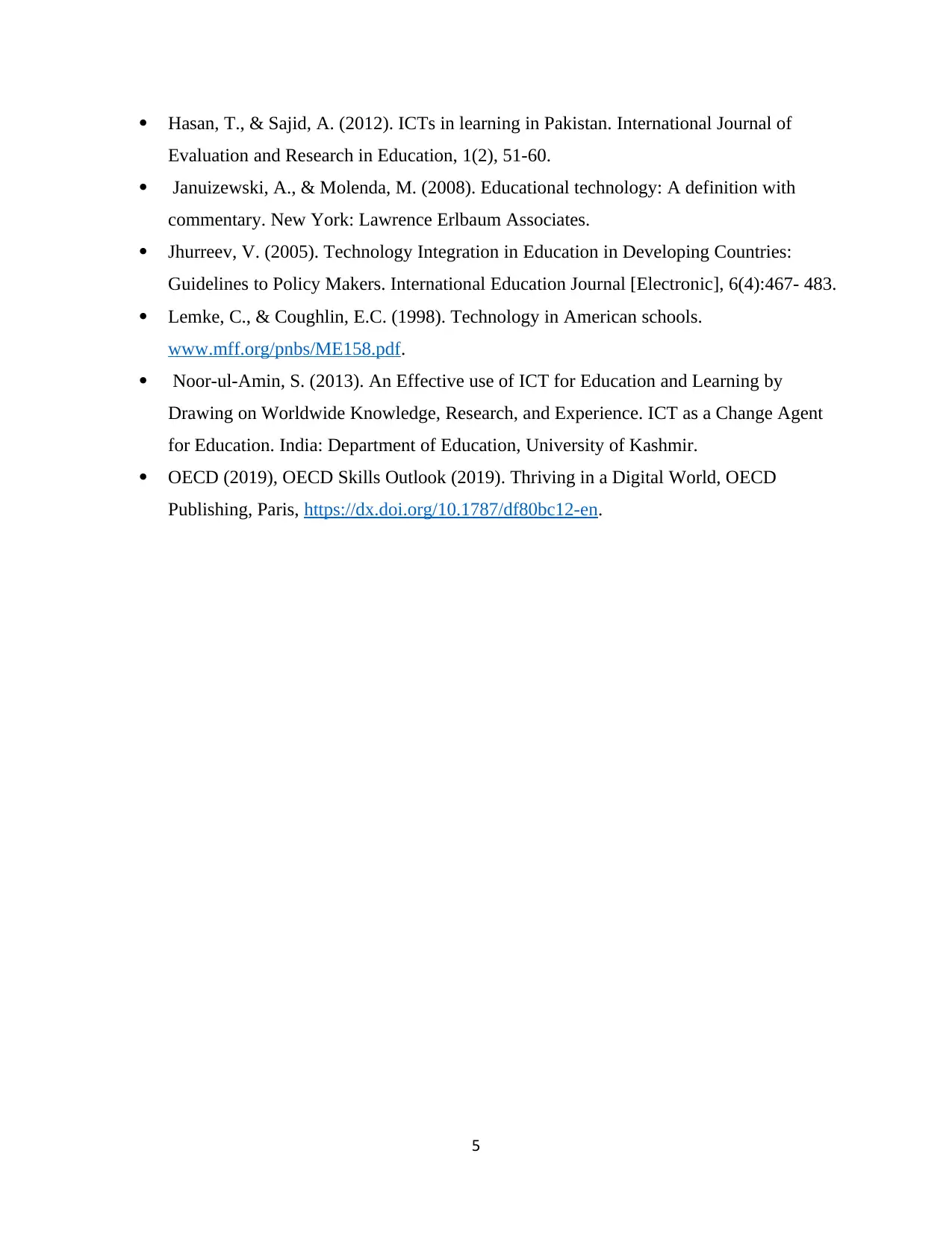
Hasan, T., & Sajid, A. (2012). ICTs in learning in Pakistan. International Journal of
Evaluation and Research in Education, 1(2), 51-60.
Januizewski, A., & Molenda, M. (2008). Educational technology: A definition with
commentary. New York: Lawrence Erlbaum Associates.
Jhurreev, V. (2005). Technology Integration in Education in Developing Countries:
Guidelines to Policy Makers. International Education Journal [Electronic], 6(4):467- 483.
Lemke, C., & Coughlin, E.C. (1998). Technology in American schools.
www.mff.org/pnbs/ME158.pdf.
Noor-ul-Amin, S. (2013). An Effective use of ICT for Education and Learning by
Drawing on Worldwide Knowledge, Research, and Experience. ICT as a Change Agent
for Education. India: Department of Education, University of Kashmir.
OECD (2019), OECD Skills Outlook (2019). Thriving in a Digital World, OECD
Publishing, Paris, https://dx.doi.org/10.1787/df80bc12-en.
5
Evaluation and Research in Education, 1(2), 51-60.
Januizewski, A., & Molenda, M. (2008). Educational technology: A definition with
commentary. New York: Lawrence Erlbaum Associates.
Jhurreev, V. (2005). Technology Integration in Education in Developing Countries:
Guidelines to Policy Makers. International Education Journal [Electronic], 6(4):467- 483.
Lemke, C., & Coughlin, E.C. (1998). Technology in American schools.
www.mff.org/pnbs/ME158.pdf.
Noor-ul-Amin, S. (2013). An Effective use of ICT for Education and Learning by
Drawing on Worldwide Knowledge, Research, and Experience. ICT as a Change Agent
for Education. India: Department of Education, University of Kashmir.
OECD (2019), OECD Skills Outlook (2019). Thriving in a Digital World, OECD
Publishing, Paris, https://dx.doi.org/10.1787/df80bc12-en.
5
1 out of 5
Related Documents
Your All-in-One AI-Powered Toolkit for Academic Success.
+13062052269
info@desklib.com
Available 24*7 on WhatsApp / Email
![[object Object]](/_next/static/media/star-bottom.7253800d.svg)
Unlock your academic potential
Copyright © 2020–2025 A2Z Services. All Rights Reserved. Developed and managed by ZUCOL.





